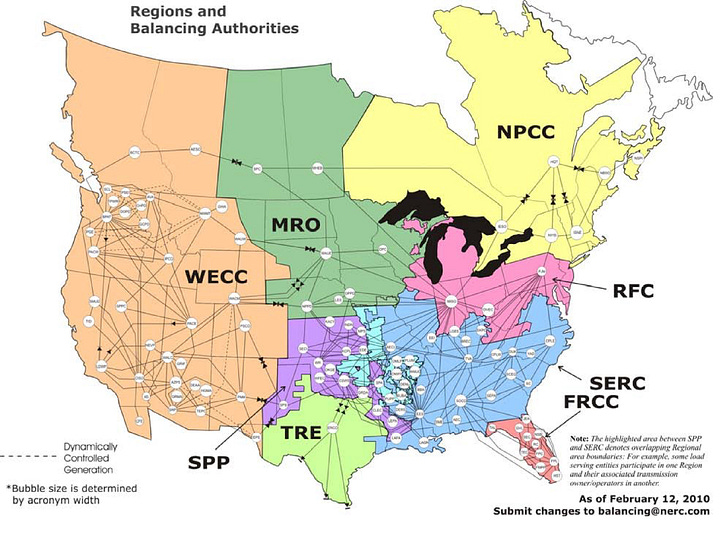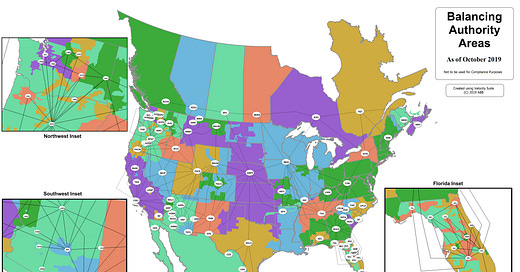Welcome back! As we dive back in, let's recap first. We now understand the following:
Magnets make the power system work.
Frequency is a direct result of the mechanical rotational speed of the synchronous generators connected to the Interconnection.
Governors help control the speed of those generators, and thus help control frequency.
The spinning generators and spinning loads have mass, and therefore have inertia, inertia helps keep the frequency of the Interconnection stable.
If you have any questions about what I’ve just listed, make a comment.
Our first question for this article, if governors do not do the fine day to day frequency control, what does? It gets complicated from here. As we discussed, North America, and the world are divided into synchronous Interconnections. From here I will talk about North America because I do not fully understand how other countries choose to organize their Interconnections. In North America, those Interconnections are divided into Balancing Authority Areas, (BAA, which is often shortened to Balancing Area, and formerly known as Control Areas), operated a Balancing Authorities (BA). Of course, these titles come from the NERC Glossary of Terms:
Balancing Authority; The responsible entity that integrates resource plans ahead of time, maintains Demand and resource balance within a Balancing Authority Area, and supports Interconnection frequency in real time.
Balancing Authority Area; The collection of generation, transmission, and loads within the metered boundaries of the Balancing Authority. The Balancing Authority maintains load-resource balance within this area.
The best way to describe a BAA might be to talk about a county. Every county has roads that enter and leave. If you think of those roads as Transmission lines, it helps make sense. If at the point that every road crossed the county line you put in a “traffic” meter to keep track of every vehicle that entered and left the county, and those meters fed to a central computer that kept a running total of how many cars there were in the county, you would be sort of close. Here are two maps of the NERC BAAs. The second older one on the right shows the asynchronous DC connections between Interconnections.


So, the Balancing Authority is responsible to “balance” the energy is its bubble. Talking in general terms, each BA forecasts the load within the boundaries of its BAA each hour and comes up with a Net Interchange scheduled (NIs) (we love our acronyms). Note that the sign of the NIs is important, negative is into the BAA, positive is out of the BAA. That NIs is loaded into the Energy Management System (EMS) for the BA. The EMS does a lot more than just this, but we are talking about Net Interchange for this conversation. In the EMS runs the Automatic Generation Control (AGC) program. AGC depends on the Area Control Error (ACE) calculation to work. So here we go, the ACE calculation (the ACE equation runs every four seconds);
ACE = (NIa - NIs ) - 10β(FA - Fs) - I ME
NIa = Net Interchange Actual; NIs = Net Interchange Scheduled
Fa = Actual Frequency; Fs = Scheduled Frequency; Frequency Bias Setting for Control Area = β(MW / 0.1)
IME = Interchange due to Meter Error
Here is an example of the ACE equation in action due to a frequency error. The Net Interchange scheduled and Net Interchange actual match, but frequency is a little low. The equation delivers an ACE of -20, meaning the BAA is 20MW deficient on generation. The AGC will send commands to generation units that are under AGC control to increase generation by 20MW.
I hear the wheels turning, “what is this frequency bias thing” Well this is what NERC says:
Frequency Bias; A value, usually expressed in megawatts per 0.1 Hertz (MW/0.1 Hz), associated with a Balancing Authority Area that approximates the Balancing Authority Area’s response to Interconnection frequency error.
It’s an estimate of the governor response of the BAAs generation to a .1Hz change, e.g. if frequency drops from 60.00 to 59.90, how will the BAA respond in MW output. (There are other factors that influence this response, but for the sake of simplicity I am ignoring them). So, the frequency bias in the example is 50MW, always entered as a negative to make the calculation work. Let’s show an example of a frequency event outside the BAA where the frequency bias was correct for a .1hz drop in frequency.
Now let’s look at a 1000MW generator trip inside the BAA that results in a .1 hz drop in frequency. Note even though the governors inside the BAA responded, the ACE equation still reports the BAA is 1000MW deficit, the amount that was lost. Now in this case it is unlikely AGC can make up 1000MW on its own. The operator will need to step in and adjust non-AGC generation and probably spin-up additional generation. He has 20 minutes to get frequency back to 60Hz or the pre-event value, or he will need to shed load to recover frequency. Notice how all the responsibility falls on the BA with the problem. (Yes, the operator can request help outside the BAA).
With every BA doing their part to control frequency and balance load, you can see how the Interconnection stays on frequency and in balance. Each BA does keep an imbalance energy account for when actual flow was off the scheduled flow, these accounts are reconciled from time to time. Also, it is rare that Frequency Bias is exactly correct and can be off a fair amount in some BAs. BPA runs a dynamic Frequency Bias that is adjusted by the EMS per system conditions throughout the operating day. It should be clear by now there needs to be dispatchable generation running at part load to make the Interconnection work. Generators running at 100% load cannot have their governors respond to a drop in frequency. Generators running at 100% load cannot be controlled to increase output by AGC.
Just for fun, here is picture the real world WECC ACE Calculation with Automatic Time Error Correction.
WOW! Now if that doesn’t give you a headache what will? I really don’t expect anyone to run that equation except maybe some of our Engineers. But it is a demonstration of some of the complex math involved in operating a power system. What I will do is post a few workbooks for download that are worksheets for playing with the basic ACE equation. Take them for a test drive if you want to play around a bit.
Here are two different workbooks that let you play with the ACE equation.
Here is a workbook that let’s you play around with the frequency bias calculation .
Here is a link to view the real time ACE value for the PJM BAA
https://dataviewer.pjm.com/dataviewer/pages/public/ace.jsf
Next let’s talk about who the players are and their roles in operating an Interconnection. Following that we can talk about how energy gets scheduled.








Well you're not wrong, part of it is the older steam only plants were forced into retirement by the subsidized energy prices.
On the topic of wind/solar energy, I think these two sentences are the key in the above article:
"Generators running at 100% load cannot have their governors respond to a drop in frequency. Generators running at 100% load cannot be controlled to increase output by AGC."
Wind and solar have been getting their unreliable intermittency covered up by eating our pre-existing margin (dispatchable generators running at less than 100%). At some point, they've eaten so much of the margin, that the grid can no longer maintain reliability and Texas, e.g., is close to that point.
One particularly galling aspect is that they were allowed to "use" that margin at no cost to themselves, and now the tax payers of Texas are having to fork out over $8B to pay for dispatchable power plants to bring back the margin that was given to wind/solar operators for free.